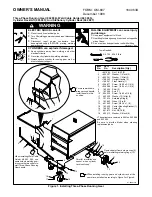
15
40.00"
19.50"
32.25" Overall
III. INSTALLATION
3.1 LOCATION (Figure 3.1)
A proper installation site should be selected for the
welding machine, if the unit is to provide dependable
service and remain relatively maintenance free.
A proper installation site permits freedom of air move-
ment into and out of the welding machine, and also least
subjects the unit to dust, dirt, moisture, and corrosive
vapors. A minimum of 18 inches (46 cm) unrestricted
space must be maintained between the welding ma-
chine side and rear panels and the nearest obstruction.
The installation site should also permit easy removal of
the welding machine outer enclosure for maintenance
functions.
CAUTION:
Do not place any filtering device over the
intake air passages of the welding ma-
chine as this would restrict the volume of
intake air and thereby subject the welding
machine internal components to an over-
heating condition and subsequent failure.
Warranty is void if any type of filtering
device is used.
If a forklift vehicle is used for lifting the unit, be sure that
the lift forks are long enough to extend completely under
the base.
Do not operate the machine without the running
gear installed.
3.2 ELECTRICAL INPUT CONNECTIONS
It is recommended that a line disconnect switch be
installed in the input circuit to the welding machine.
This would provide a safe and convenient means to
completely remove all electrical power from the weld-
ing machine whenever it is necessary to perform any
internal function on the unit. (See Figure 3.2A.)
Before making electrical input connections to the
welding machine, “Machinery Lockout Procedures”
should be employed. If the connections are to be
made from a line disconnect switch, the switch should
be padlocked in the off position. If the connection is
made from a fusebox, remove the fuses from the box
and padlock the cover in the closed position. If
locking facilities are not available, attach a red tag to
the line disconnect switch (or fuse box) to warn others
that the circuit is being worked on. If the plug-cap is
used, (see 3.2B) remove plug from receptacle.
3.2.1 Input Electrical Requirements
Models of this welding machine are designed to be
operated from 208/230, or 208/230/380/400/460/575 volts
single phase 50/60 Hz, depending on model. The primary
input voltage requirements are shown on the welding
machine nameplate.
Figure 3.1 Dimensional Drawing
SECTION 3 INSTALLATION
Summary of Contents for MIGMASTER 250
Page 1: ...F15 087 J 04 2003 MigMaster 250 Welding Package Instruction Manual...
Page 4: ...4 TABLE OF CONTENTS...
Page 22: ...22 SECTION 3 INSTALLATION...
Page 38: ...38 Figure 5 3 Wiring Migmaster 250 for 208 230 V Model D 32861 F...
Page 39: ...39 Figure 5 4 Wiring Migmaster 250 for 208 230 380 400 460 575 V Model D 33311 D...
Page 40: ...40 SECTION 5 SERVICE...
Page 52: ...52 SECTION 6 REPLACEMENT PARTS...
Page 53: ...53 NOTES...
Page 54: ...NOTES...
















































